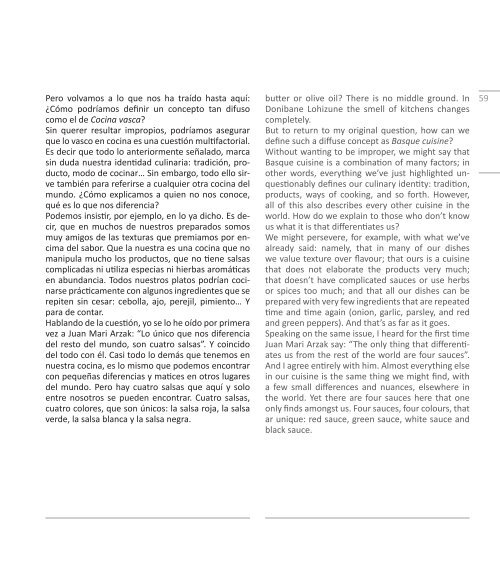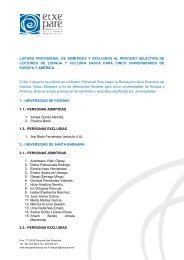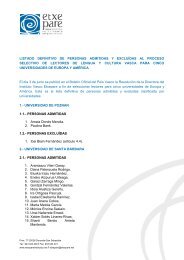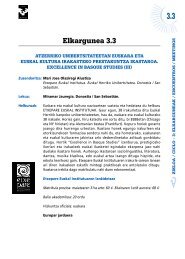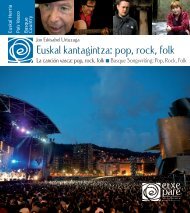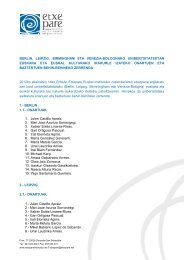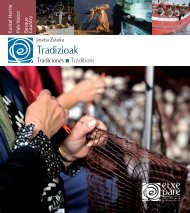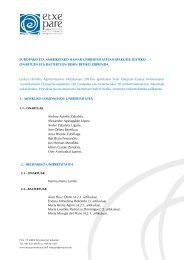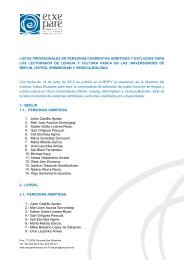Euskal sukaldaritzaz - Etxepare, Euskal Institutua
Euskal sukaldaritzaz - Etxepare, Euskal Institutua
Euskal sukaldaritzaz - Etxepare, Euskal Institutua
You also want an ePaper? Increase the reach of your titles
YUMPU automatically turns print PDFs into web optimized ePapers that Google loves.
Pero volvamos a lo que nos ha traído hasta aquí:<br />
¿Cómo podríamos definir un concepto tan difuso<br />
como el de Cocina vasca?<br />
Sin querer resultar impropios, podríamos asegurar<br />
que lo vasco en cocina es una cuestión multifactorial.<br />
Es decir que todo lo anteriormente señalado, marca<br />
sin duda nuestra identidad culinaria: tradición, producto,<br />
modo de cocinar… Sin embargo, todo ello sirve<br />
también para referirse a cualquier otra cocina del<br />
mundo. ¿Cómo explicamos a quien no nos conoce,<br />
qué es lo que nos diferencia?<br />
Podemos insistir, por ejemplo, en lo ya dicho. Es decir,<br />
que en muchos de nuestros preparados somos<br />
muy amigos de las texturas que premiamos por encima<br />
del sabor. Que la nuestra es una cocina que no<br />
manipula mucho los productos, que no tiene salsas<br />
complicadas ni utiliza especias ni hierbas aromáticas<br />
en abundancia. Todos nuestros platos podrían cocinarse<br />
prácticamente con algunos ingredientes que se<br />
repiten sin cesar: cebolla, ajo, perejil, pimiento… Y<br />
para de contar.<br />
Hablando de la cuestión, yo se lo he oído por primera<br />
vez a Juan Mari Arzak: “Lo único que nos diferencia<br />
del resto del mundo, son cuatro salsas”. Y coincido<br />
del todo con él. Casi todo lo demás que tenemos en<br />
nuestra cocina, es lo mismo que podemos encontrar<br />
con pequeñas diferencias y matices en otros lugares<br />
del mundo. Pero hay cuatro salsas que aquí y solo<br />
entre nosotros se pueden encontrar. Cuatro salsas,<br />
cuatro colores, que son únicos: la salsa roja, la salsa<br />
verde, la salsa blanca y la salsa negra.<br />
butter or olive oil? There is no middle ground. In<br />
Donibane Lohizune the smell of kitchens changes<br />
completely.<br />
But to return to my original question, how can we<br />
define such a diffuse concept as Basque cuisine?<br />
Without wanting to be improper, we might say that<br />
Basque cuisine is a combination of many factors; in<br />
other words, everything we’ve just highlighted unquestionably<br />
defines our culinary identity: tradition,<br />
products, ways of cooking, and so forth. However,<br />
all of this also describes every other cuisine in the<br />
world. How do we explain to those who don’t know<br />
us what it is that differentiates us?<br />
We might persevere, for example, with what we’ve<br />
already said: namely, that in many of our dishes<br />
we value texture over flavour; that ours is a cuisine<br />
that does not elaborate the products very much;<br />
that doesn’t have complicated sauces or use herbs<br />
or spices too much; and that all our dishes can be<br />
prepared with very few ingredients that are repeated<br />
time and time again (onion, garlic, parsley, and red<br />
and green peppers). And that’s as far as it goes.<br />
Speaking on the same issue, I heard for the first time<br />
Juan Mari Arzak say: “The only thing that differentiates<br />
us from the rest of the world are four sauces”.<br />
And I agree entirely with him. Almost everything else<br />
in our cuisine is the same thing we might find, with<br />
a few small differences and nuances, elsewhere in<br />
the world. Yet there are four sauces here that one<br />
only finds amongst us. Four sauces, four colours, that<br />
ar unique: red sauce, green sauce, white sauce and<br />
black sauce.<br />
59


